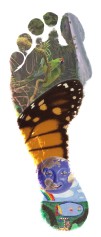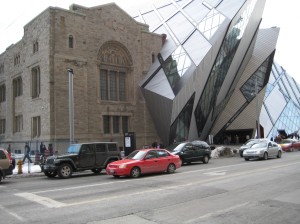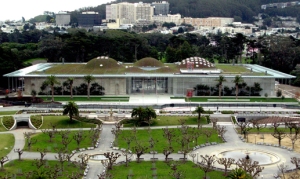
Photo credit: Royal Saskatchewan Museum
In 2003, humanity’s “ecological footprint” was at least 20% greater than the amount of productive land and freshwater that makes up our Earth’s ‘carrying capacity’… and it continues to grow.
Our enormous footprint is responsible for a host of urgent problems, including climate change, declining biodiversity, widespread pollution, and widening socio-economic disparities.
Many of these problems reflect how people live – our cultures – so, as trusted and respected cultural organizations, museums have an opportunity, if not an obligation, to address them.
QUESTION:
Which of these two museum building projects is more likely to foster a “culture of sustainability?’

Royal Ontario Museum Expansion 2007. Has this renovation/expansion, at a cost of over $300,000,000, contributed to the cultural well-being of Toronto?

California Academy of Science
San Francisco. Opened 2008.
Capital budget: almost $500,000,000.
Answer: It really depends on what impacts they both have on the lives of people who engage in their public programs. What measures of ’sustainability’ should museums be using?
*************
“Development divorced from its human or cultural context
is growth without a soul.”
from ‘Our Creative Diversity’, UNESCO, 1995
This site is dedicated to exploring the ways in which museums, from around the world, are responding to the ‘winds of change’ – winds that are blowing within and outside museums. Above all, we are looking for inspiring stories of how museum professionals have created novel initiatives that have had meaningful cultural impacts. And by ‘cultural impacts’ we are hoping to have contributors address the ways that public programs have affected individuals and communities, as well as how museums function as ‘learning organizations’ that are well connected to the cultural needs of society. We also are looking for initiatives that address the global challenges of our day.
Most people agree that “culture” is a difficult term to define. So, for the purposes of this site, we are providing two definitions that we hope will stimulate reflection and discussion:
1. Culture is… “a basic pattern of assumptions invented, discovered or developed by a given group as it learns to cope with its problems of external adaptation and internal integration” by Edgar Shein, in Mastering Civic Engagement, American Association of Museums
2. Culture is ….“the sum total of all values, collective memory, history, beliefs, mythology, rituals, symbolic objects and built heritage which reflect the manner in which a people relate to aspects of life which:
- they can know and control; as well as
- those they can’t fully know or control, but to which they must have a conscious relationship. (Douglas Worts, “On the Brink of Irrelevance: Art Museums and Contemporary Society”, in Researching Visual Arts Education in Museums and Galleries: An International Reader, 1995
There is a ‘Background’ page in this blog, which may provide helpful thoughts for understanding the impetus that created this site and how best to contribute to ‘Museums in the Winds of Change’.
We welcome contributions in which entire museums, specific exhibits or other public programs are reviewed and assessed to shed light on how well they have engaged individuals and communities, promoted reflection, stimulated dialogue and prompted personal or collective change.
The creators of this blog (Douglas Worts and Glenn Sutter) are suggesting the use of the “Critical Assessment Framework” (CAF) as a way to analyze projects so they can be compared to each other. The CAF was developed by the “Canadian Working Group on Museums and Sustainable Communities” in the mid 2000s, and subsequently adapted by Worts and Sutter. An article, entitled “Measuring Museum Meanings: A Critical Assessment Framework” was published by Worts in the Journal of Museum Education, vol 31, #1.